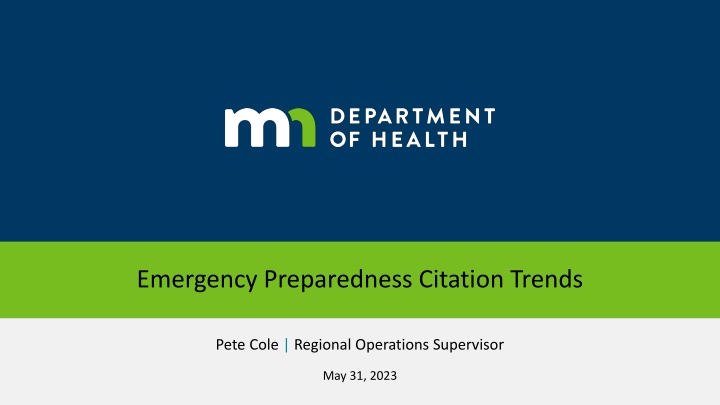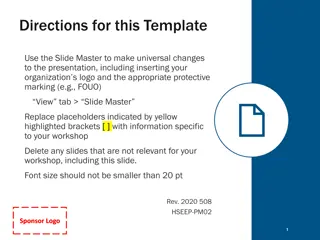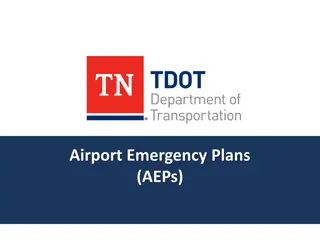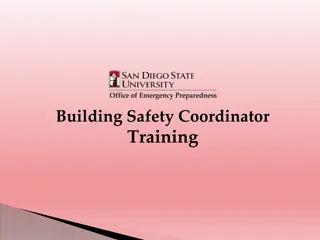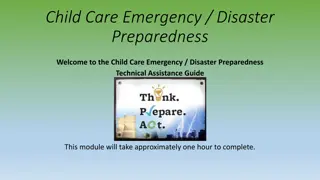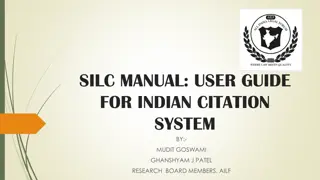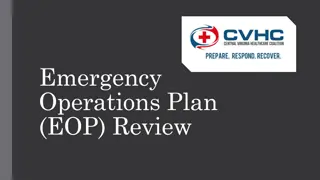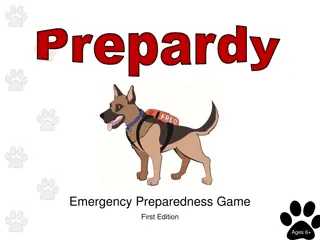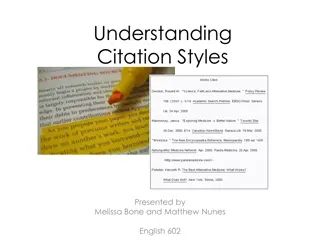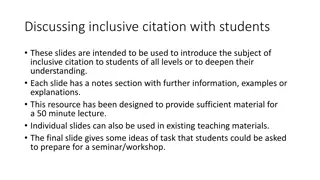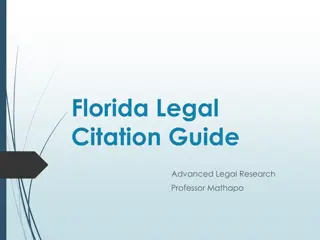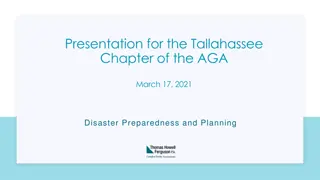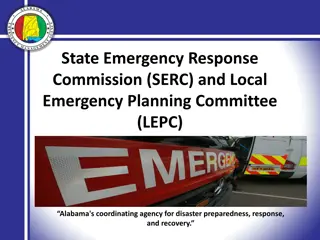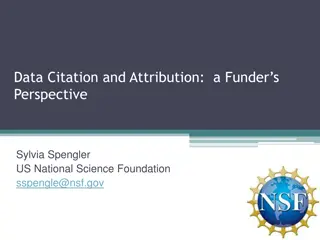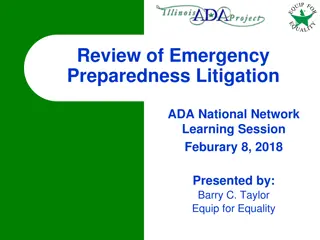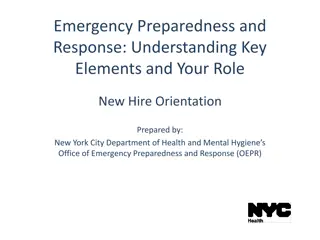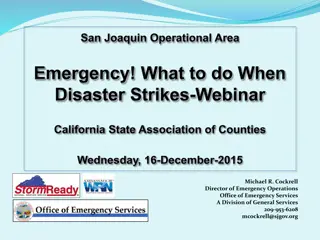Emergency Preparedness Citation Trends
This document discusses the citation trends in emergency preparedness, as presented by Pete Cole, the Regional Operations Supervisor on May 31, 2023. The analysis delves into the patterns of citations related to emergency preparedness and highlights potential areas for improvement and further research in this critical field. Understanding these trends can aid in enhancing overall emergency preparedness strategies and ensuring effective response mechanisms are in place.
Download Presentation

Please find below an Image/Link to download the presentation.
The content on the website is provided AS IS for your information and personal use only. It may not be sold, licensed, or shared on other websites without obtaining consent from the author.If you encounter any issues during the download, it is possible that the publisher has removed the file from their server.
You are allowed to download the files provided on this website for personal or commercial use, subject to the condition that they are used lawfully. All files are the property of their respective owners.
The content on the website is provided AS IS for your information and personal use only. It may not be sold, licensed, or shared on other websites without obtaining consent from the author.
E N D
Presentation Transcript
Emergency Preparedness Citation Trends Pete Cole | Regional Operations Supervisor May 31, 2023
Objectives Demonstrate knowledge of the most frequently cited emergency preparedness citations Understand the fundamental reasons why the citations are being cited Demonstrate recommended actions to maintain compliance Understand sources for updated infection control guidance 2
Citation Overview EP Citations over 2 Years 0 5 10 15 20 25 30 35 E0041 - Hospital CAH and LTC Emergency Power E0037 - EP Training Program E0004 - Develop EP Plan, Review and Update Annually E0039 - EP Testing Requirements E0007 - EP Program Patient Population E0035 - LTC and ICF/IID Sharing Plan with Patients E0032 - Primary/Alternate Means for Communication E0025 - Arrangement with Other Facilities E0034 - Information on Occupancy/Needs E0024 - Policies/Procedures-Volunteers and Staffing E0015 - Subsistence Needs for Staff and Patients E0006 - Plan Based on All Hazards Risk Assessment E0013 - Development of EP Policies and Procedures E0031 - Emergency Officials Contact Information E0036 - EP Training and Testing E0023 - Policies/Procedures for Medical Documentation E0018 - Procedures for Tracking of Staff and Patients E0026 - Roles Under a Waiver Declared by Secretary E0029 - Development of Communication Plan E0030 - Names and Contact Information E0022 - Policies/Procedures for Sheltering in Place E0001 - Establishment of the Emergency Program (EP) E0033 - Methods for Sharing Information E0020 - Policies for Evac. and Primary/Alt. Comm.
Top Ten Deficiencies 1. LTC Emergency Power TOP 10 2. EP training program 3. Review and update annually 0 32 E0041 - HOSPITAL CAH AND LTC 17 E0037 - EP TRAINING PROGRAM 4. EP Testing Requirements 12 E0004 - DEVELOP EP PLAN, 5. EP Program patient population 11 E0039 - EP TESTING 10 6. Sharing plan with residents/family E0007 - EP PROGRAM PATIENT 10 E0035 - LTC AND ICF/IID 7. Primary & Alternate means for communication 9 E0032 - PRIMARY/ALTERNATE 8. Arrangements with other facilities 6 E0025 - ARRANGEMENT WITH 6 E0034 - INFORMATION ON 9. Information on occupancy/needs 6 E0024 - POLICIES/PROCEDURES- 10. Policies/procedures for volunteers and staffing 3/7/2025 health.state.mn.us 4
E0041 - LTC Emergency Power Currently the most commonly cited EP citation. CMS requires LTC facilities to comply with the 2012 edition of the National Fire Protection Association (NFPA) 101 Life Safety Code (LSC) and the 2012 edition of the NFPA 99 Health Care Facilities Code in accordance with the Final Rule (CMS 3277 F). Most common concerns Missing weekly visual inspections Missing monthly run tests Not achieving 30% of capacity on every monthly run test or supplementing with an annual 1.5-hour load bank for diesel generators Missing 36-month four-hour load bank test 3/7/2025 health.state.mn.us 5
E037 - EP Training Program Regulation Summary Training must be specific to the facility and plan Training is required initially and annually Documentation of training must be maintained Expectations Staff must demonstrate knowledge of training Be able to show training for volunteers and contracted staff Be prepared for review of staff education files to show training
E037 Training -What Initial and annual Specific to facility training to all staff Maintain documentation of training Demonstrate staff knowledge 7
E037 Training -Who Regular Staff Volunteers Contracted Staff 8
E004 - Review and Update Annually The plan must be reviewed and updated at least annually. The annual review must be documented to include the date of the review and any updates made to the emergency plan based on the review. The format of the emergency preparedness plan updates is at the facility s discretion. 3/7/2025 health.state.mn.us 9
E0039 - EP Plan Testing Requirements Documentation of testing is required in the last year. Needs to be 1. 2. 3. Two community-based exercises One community based & one tabletop exercise Have actually activated their plan. Must be documented Must have an after-action analysis Must include a plan revision based on the after-action analysis 3/7/2025 health.state.mn.us 10
E007 - EP Program Patient Population The emergency plan must specify the population served within the facility, including their unique vulnerabilities in the event of an emergency or disaster. The emergency plan must also address the types of services that the facility would be able to provide in an emergency. Resident populations unique to the facility that are most at risk should be identified and the EPP should document how continuity of operations will be provided for these residents. 3/7/2025 health.state.mn.us 11
E0035 - Sharing EPP with Resident and Families LTC facilities and are required to share emergency preparedness plans and policies with family members and resident representative. Facilities have flexibility in deciding what information from the emergency plan should be shared. Options include providing instructions on how to contact the facility in the event of an emergency on the public website or to include the information as part of the facility s admission procedures. 3/7/2025 health.state.mn.us 12
E0032 - Primary & Alternate Means of Communication Facilities are required to have primary and alternate means of communicating with staff, Federal, State, tribal, regional, and local emergency management agencies. Facilities have the discretion to utilize alternate communication systems that best meets their needs. The communication plan should include procedures regarding when and how alternate communication methods are used, and who uses them. 3/7/2025 health.state.mn.us 13
E0025 - Arrangements with other Facilities Facilities are required to have policies and procedures which include prearranged transfer agreements, which may include written agreements or contracted arrangements with other facilities and other providers to receive patients during and emergency. The facility agreements should include pre-arranged agreements for transportation between the facilities. The arrangements should be in writing, such as Memorandums of Understanding (MOUs) and Transfer Agreements, in order to demonstrate compliance. 3/7/2025 health.state.mn.us 14
E0034 - Information on Occupancy/Needs Facilities must have a means of providing information about the facility s needs and its ability to provide assistance to the authority having jurisdiction local and State emergency management agencies, local and state public health departments, the Incident Command Center, the Emergency Operations Center, or designee. Regulations don t prescribe the means that facilities must use in disseminating the required information. However, facilities should include in its communication plan, a process to communicate the required information. 3/7/2025 health.state.mn.us 15
E0034 - MNTrac 3/7/2025 health.state.mn.us 16
E0024 - Policies and Procedures for Volunteers Policies and procedures must address the use of volunteers in an emergency and other emergency staffing strategies to address surge needs during an emergency. These may also include federally designated health care professionals, such as Public Health Service (PHS) staff, National Disaster Medical System (NDMS) medical teams, Department of Defense (DOD) Nurse Corps or Medical Reserve Corps (MRC). 3/7/2025 health.state.mn.us 17
Updated Infection Control Guidance Staff and resident vaccination requirements continue in effect Information related to impending changes to vaccination requirement is found here: https://www.cms.gov/files/document/qso-23-13-all.pdf 3/7/2025 health.state.mn.us 18
Updated Infection Control Guidance Source control is recommended more broadly as described in CDC s Core IPC Practices in the following circumstances: By those residing or working on a unit or area of the facility experiencing a SARS-CoV-2 or other outbreak of respiratory infection; universal use of source control could be discontinued as a mitigation measure once the outbreak is over (e.g., no new cases of SARS-CoV-2 infection have been identified for 14 days); or Facility-wide or, based on a facility risk assessment, targeted toward higher risk areas (e.g., emergency departments, urgent care) or patient populations (e.g., when caring for patients with moderate to severe immunocompromise) during periods of higher levels of community SARS-CoV-2 or other respiratory virus transmission 3/7/2025 health.state.mn.us 19
References State Operations Manual Appendix Z- Emergency Preparedness for All Provider and Certified Supplier Types Interpretive Guidance (Rev. 204, Issued: 04-16-21) MDH Monthly LTC COVID-19 Call 5/10/23 MDH Monthly LTC COVID-19 Cal 5/10/2023
Questions? 3/7/2025 health.state.mn.us 21
Thank You! Pete Cole Peter.cole@state.mn.us 651-249-1724
